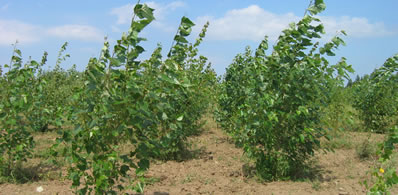Bioeconomic models
Assessing the cost and benefits of forest biomass

Two-year-old hybrid poplar plantation in Claremont, Ontario
Larger image [135 kb JPG]
Governments and industry across Canada are looking for the best ways to tap the enormous potential of forest biomass in the production of bioenergy and other value-added products. Economic models provide a framework for quantifying both costs and benefits and are therefore an essential tool for supporting these decisions.
In collaboration with the Canadian Wood Fibre Centre and other partners, Canadian Forest Service (CFS) researchers at the Great Lakes Forestry Centre have developed several bioeconomic models to help assess the economic attractiveness of fibre production and other potential benefits of biomass from fast-growing plantations.
For example, the first-generation CFS-Afforestation Feasibility Model (CFS-AFM) addressed both biophysical and economic aspects of afforestation by linking biomass growth and carbon-tracking algorithms within a cost–benefit framework. This model was used exclusively in the Feasibility Assessment of Afforestation for Carbon Sequestration and Forest 2020 Plantation Demonstration and Assessment initiative to assess the feasibility of fast-growing trees.
In response to added demands, the CFS-Forest Bioeconomic Model (CFS-FBM), which uses specified time horizons and improved carbon modeling, was developed. The CFS-FBM addresses more complex forest management and bioenergy scenarios, such as species rotation, fixed time horizons and multiple harvests.
The Short Rotation Coppice-Greenhouse Heating Model (SRC-GHM) has also been developed to examine investment options like heating greenhouses with purpose-grown biomass. The SRC-GHM produces several economic metrics, such as break-even prices, sensitivity to change of model input parameters, fossil fuel substitution benefits and can be used to determine the amount of plantation area required to satisfy heating demands.
Other applications for the models, including examining the potential of residual biomass from harvesting operations for bioenergy, are now in development.
Policy-makers and planners may find these models useful. More details are available on request.
Contact Dan McKenney.
Find more information
Canadian Forest Service publications
- The economic attractiveness of short rotation coppice biomass plantations for bioenergy in northern Ontario
- Effects of permanence requirements on afforestation choices for carbon sequestration for Ontario, Canada
- An economic assessment of the use of short- rotation coppice woody biomass to heat greenhouses in southern Canada
- Canadian Forest Service publications
Page details
- Date modified: